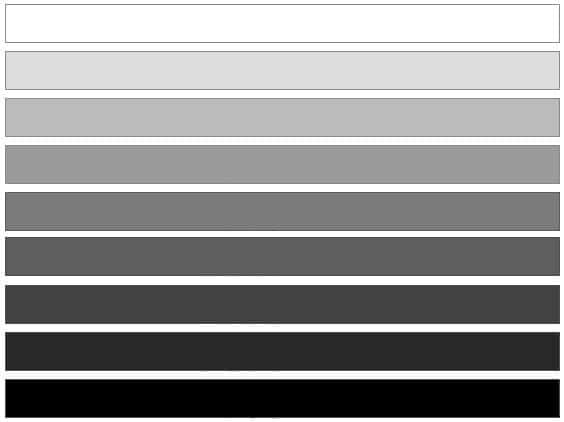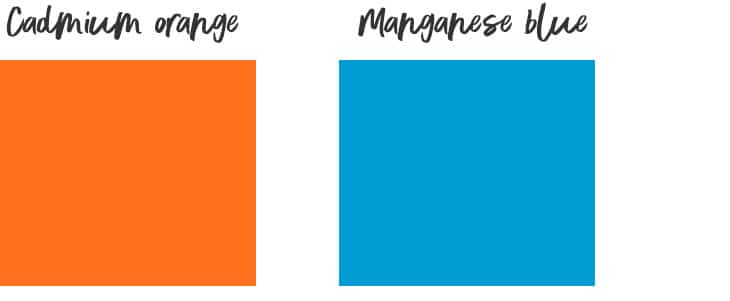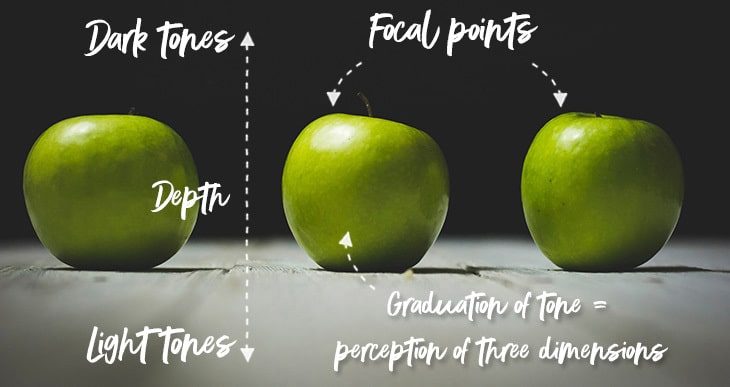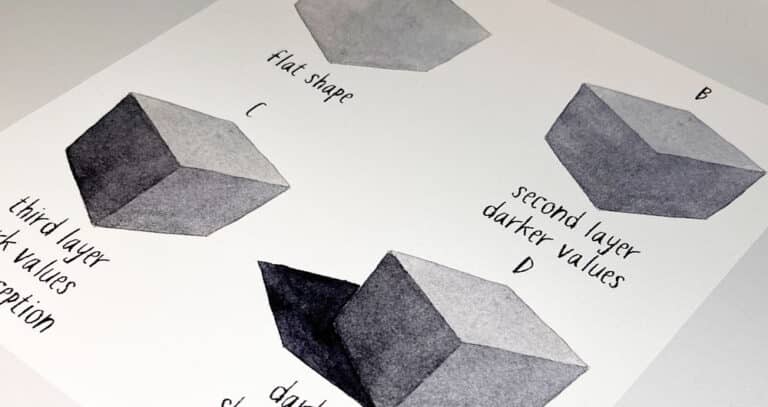What is tone in Art – a Watercolorists Guide

You’ve probably heard artists talking about “tone” when describing art. When I first started watercolor painting I was a bit confused by all the vocabulary. One of my favorite artists Stan Miller talks a lot about value and tone and describes this as one of the fundamentals of good painting. You might also hear artists talking about “tonal value” in art or just “value”. These terms both mean the same thing as “tone”.
But what is tone in art?
Tone is the relative lightness or darkness of a color. Tonal value describes how light or dark a color is independent of its hue (hue being the color appearance – red, green, blue etc). For example a blue and a red color can both have exactly the same tonal value even though the color appearance is different.
Of all the factors that an artist needs to take into consideration, judging tone and value is an essential first step in evaluating a scene. Whether your style of painting is loose and blurry or detailed and precise, if the relative tones in your scene are true, you can produce a believable sense of space, light and form.

Because we see and understand objects as a result of how light or dark they are, tone is very important to artists. Tone and value are more important than color to the success of a painting. Understanding and using tone correctly can have a big impact on your finished work. To use tone well, you need to develop a different way of looking at color and interpreting a scene onto paper.
In watercolors it is particularly important to assess the tonal graduations of the scene you are going to paint. Adding darkness to watercolor is simple, but adding lightness can’t be done! The transparency of watercolor means you need to make evaluations about tone at the beginning of the painting process. With watercolors, once you give a form a certain value, it is impossible to make it lighter. This is why in watercolor painting you need to reserve the white areas of the paper for the lightest tones in your scene.
Watercolor painting is very much about balancing lightness and darkness.
Tonal values and value scale in painting
As an artist you need to be able to recognize by eye the different values of light and dark.
This is done using a value scale. The traditional value scale used by artists includes nine gradually increasing tones from pure white to pure black. This concept was originally created by the american artist and scholar Denman Ross at the beginning of the 20th century. His nine step value scale describes how values change from white to black and is still used by artists to this day.
These values are rated from 1 to 9 and are described using the following terms:
- White
- High light
- Light
- Low light
- Mid value
- High dark
- Dark
- Low dark
- Black

Starting with white, each step increases in tonal value by 12.5% until you end up with black.
This value scale is still widely used today as a visual reference and guide for determining values.
These nine variations in tone are easy to observe, and are sufficiently different to the eye to help us analyse and break down any scene we want to translate into painting.
The PDF below contains a nine step value chart that you can download and print so that you have a usable scale to hand, for use in your studio or in the field. For best results, print it on a good quality printer with the options set to ‘black and white’.
You can also buy preprinted value scales – I have one made by The Color Wheel Company.
I find that having a value scale to hand when you work is an incredibly useful tool to help judge tone.
Tone hue and saturation
Assessing tone in black and white is fairly simple. However, when it comes to judging the value of a colored hue a lot of artists slip up! This is especially true for bright hues such as orange. Take a look at the two saturated hues below. How would you rate their value using a Denman Ross scale? Most people would naturally tend to appraise these colors as light toned.

But in reality these hues are more like mid values. See below:

Some saturated colors are easily confused as visually lightness. Our perception of tone can be misled by the bright hues of certain colors. As a result we tend to misjudge the actual values of the different colors in a scene.
Because it’s so difficult to judge the value of watercolor pigments by eye, Bruce MacEvoy, the author of the website Handprint has created an artists value wheel. This visual aid is a useful tool for determining the tonal value of different paint pigments. You can download it from the link above.
What is tone in art and why is it important?
When you look at a painting, variations in tone and value help your perception of form. The lightness or darkness of surfaces in a picture provide a sense of three dimensional space and also the depth or distance in a scene.
By controlling the value of the colors you apply, you can achieve an impression of form and distance, and also strengthen the focus of your paintings. Tone is therefore important for the following objectives:
- Depth
- Focal points
Using tone correctly creates an illusion of depth. And using light and dark tones on a subject gives the illusion of three dimensional form. The human eye is also drawn to something light set against something darker. An important rule of composition is that the eye is attracted to the greatest point of contrast. By carefully using tone you can create a focal point in your paintings.
As an example, take a look at the following photo of some apples. If we were going to paint this as a still life, we need to reproduce similar tones as the original image.
Notice how the dark toned background contrasts with the lighter toned apples, making them stand out. The dark toned background becomes a light toned foreground which helps reinforce the sense of depth. Also the sharp highlights to the apples help to generate the focal points of the image.

To make it easier to asses the tonal value of the different parts of the image, here is a black and white version of the same photo. Doing this makes a difficult subject easier to paint. If you often work from photos then this is a useful exercise to do when you’re starting out. This is just a desaturated grayscale version of the photo without any other changes.

As you can see, it starts to become a little easier to find the different values in the photo. By pixelating the image and using our nine step value scale we can more readily locate the different graduations of tone throughout the image.

Creating depth by controlling tonal value
Here is another example of how to correctly use tone to establish a sense of depth. You can try this easy exercise yourself. This simplified scene of a range of mountains illustrates the right and wrong way to use values to generate the appearance of depth.
In order for the mountains in the distance to recede, they need to be lighter in tone.

Here is what happens when the distant mountains are painted a darker shade. They jump out at you, and the perception of depth is confused.

Creating three dimensional form and highlights by controlling tonal value.
To make something look three dimensional, you need the light and dark tones to do the work for you. The sphere below illustrates how to use gradation of tone to create the illusion of three dimensional form. The reserved white area creates a focal point or highlight.

This seems a pretty obvious example. By reserving some of the white paper we create a highlight. The “Light” and “mid values” describe the side of the sphere turned towards the light source. Dark values indicate the areas in shade. The effect as a whole depicts a three dimensional form.
Making a watercolor value chart
It’s a good idea to practice making your own watercolor value scale. It helps you to learn the proportion of water needed to create lightness or darkness for any one color. You can also use this chart in your work, as a visual aid to evaluating the values of any scene you want to paint.
You don’t have to restrict this to a black and white study – you can also paint value charts for other colors. If you’re new to color mixing you may want to try making your own mixing charts such as a color wheel or a mixing chart. These are great exercises for getting to know your watercolors.
A good method for painting your value scale is by applying multiple glazes of diluted black watercolor, leaving the paint to dry between each layer of watercolor. The successive layers of paint become darker and darker.
- Mix some black paint, or simply use a tube of black if you have one available.
- Draw a grid of 9 boxes.
- Leave the first box white and paint ALL THE OTHER BOXES (boxes 2 to 9) with a diluted black mixture.
- When this is dry, paint another layer of diluted black over boxes 3 to 9 (leaving the light grey color in box number 2).
- Then do the same thing for boxes 4 to 9, and so on, until you have a value scale from white to black.
It doesn’t matter if this is not completely accurate. You can always apply a new glaze of paint if you think one of the boxes is too light. You can also use a printed value scale to help you judge the values of each watercolor glaze.
Tips on how to judge and use tone.
With watercolor painting, it is especially important to ask yourself at the beginning of your project, what is the lightest part of the picture?
Hopefully the tools discussed above will help you find the lightest shapes in any picture you want to paint.
- Use a black and white value scale. You can either download and print the one above, paint your own, or find a preprinted value scale.
- If you have problems judging color values, consider making value scales for primary and secondary colors. You can paint these yourself using a black & white value scale as a guide.
- Another visual aid for estimating value is to simply cut out a square of card or watercolor paper, then cut a square hole in the center of the card. Hold this up to your scene or photo to isolate small areas of the scene. Isolating portions of a scene can make it easier to determine a value!
- If you’re working from a photo why not desaturate the image first to see a grayscale version. Doing this makes a difficult subject easier.
- Before you start your final painting, consider sketching a monochromatic value study to help you determine the tones in your picture.
- Think about how to use tone to create focal points in your composition. The eye is attracted to the greatest point of contrast.
Try to think of your subject in an abstract way in the early stages of a painting. Think in terms of shapes and tones rather than things. Try not to be misled by meaning. For example if you want to paint a red brick house, your brain thinks “house with a brick texture”. Instead try to see it as a “red box”.
It can be difficult sometimes to ignore your brain! So think in terms of pure form and tonal value.
Have a great day with your watercolors!



Thank you so much for this insightful article. This paired with your youtube video on the same topic has helped me a lot – I was able to paint a red apple with the correct tones. 🙂 Even I was surprised because I hadn’t painted in decades! Again, thank you for sharing this.
Great news 🙂
Glad the tutorial was useful…
Loved your explanation , it is helpful….
Thanks
Glad it was useful Nandini !
I liked it! One of the few sites that actually describe what a mid tone is. Thank you